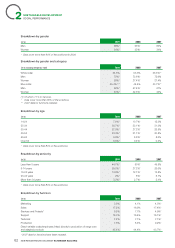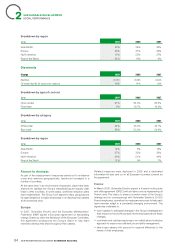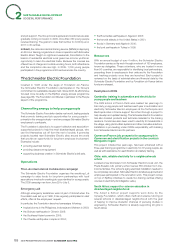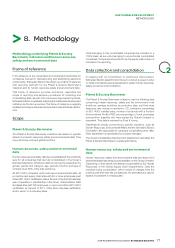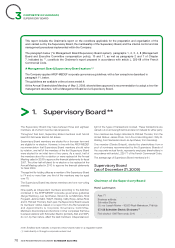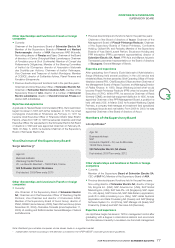APC 2009 Annual Report Download - page 69
Download and view the complete annual report
Please find page 69 of the 2009 APC annual report below. You can navigate through the pages in the report by either clicking on the pages listed below, or by using the keyword search tool below to find specific information within the annual report.
2009 REGISTRATION DOCUMENT SCHNEIDER ELECTRIC 67
SUSTAINABLE DEVELOPMENT
2
SOCIETAL PERFORMANCE
Planet & Society Barometer’s
improvement plans
Three indicators in Schneider Electric’s Planet & Society Barometer
measure the BipBop programme ’s success:
•One million households from the base of the pyramid have acces
to energy with Schneider Electric solutions
Performance at Jan. 1, 2009 Dec. 31, 2009
2.00 4.08
•10,000 young people from the base of the pyramid trained in
electricity
Performance at Jan. 1, 2009 Dec. 31, 2009
2.00 3.72
• 500 new entrepreneurs from the base of the pyramid start their
own business in the electricity market
Performance at Jan. 1, 2009 Dec. 31, 2009
2.00 4.00
Examples in 2009
In September2009, Schneider Electric announced the creation of
a global socially responsible venture capital fund called Schneider
Electric Energy Access, with an initial capital of EUR3million.
The fund’s mission is to support the development of entrepreneurial
initiatives worldwide that will help the poorest among us obtain
access to energy. Created with the backing of Crédit Coopératif,
Schneider Electric Energy Access will fi nance projects designed to:
•help jobless individuals create businesses in electricity;
•promote the development of businesses that provide energy
access in rural or suburban areas in developing countries;
•support the deployment of innovative energy access solutions that
use renewable energies for people at the bottom of the pyramid.
The fund supports both the Investment and Business aspects
of the BipBop programme . It intends to bring together different
stakeholders by encouraging Schneider Electric’s employees
and business partners around the world to play an active role in
making this commitment a reality. The structure of this fund, which
is designed to promote responsible development, represents an
original and innovative response to the latest legislation on employee
savings. The fund illustrates the shared societal commitment of the
entire corporate community (see page 59 ).
Business
In France, Schneider Electric set up a project two years ago in
partnership with Association pour le Droit à l’Initiative Économique
(ADIE) to help entrepreneurs start electricity-related businesses. The
goals are to:
•help individuals who have in some cases been out of the workforce
for several years create their own jobs in a promising industry;
•contribute to the local economy;
•promote the electrical profession.
The project targets entrepreneurs who do not have access to bank
loans, notably the unemployed and low-income individuals.
Schneider Electric and Schneider Initiatives Emploi, an association
that nurtures spin-offs, fi nance part of the microloans granted to
electrical businesses through ADIE. Their ambition was to support
100 businesses in 2009. Schneider Electric’s French sales division
has also created a pack with dedicated technical training resources
combined with support from a local sales representative to help
these entrepreneurs.
Innovation
Solution in Madagascar
In a country where only 20% of the population has access to
electricity, Schneider Electric is supporting the Jirano association,
whose mission is to deploy energy access solutions and train
residents on how to use and maintain them. In particular, Jirano
is working in a mining region in which local residents are being
relocated to accommodate a major project. This involves creating
new villages and infrastructure. Jirano proposed an innovative
photovoltaic solution for one such village with remote supervision
and monitoring of the electrical enclosure via the GSM network.
Thanks to this initiative, residents have had access to electricity
since May2009. Ground should be broken on similar projects in
Madagascar in 2010.
This initiative was recognised with the 2009 Planet & Society special
prize at the One company programme ’s awards ceremony.
Innovation in India
Lighting is a fi rst step in any programme to provide electricity to
disadvantaged populations, as it promotes entrepreneurial initiative
and makes it possible to study even after the sun has gone down.
Schneider Electric had developed a very-low-cost home lighting
system called In-Diya that comprises a lamp made up of 90X 4.5W
LEDs that can be connected to a battery supplied by a photovoltaic
panel. The lamp provides the equivalent of two 60W incandescent
light bulbs or one 11W CFL energy saver light bulb. With an estimated
lifespan of 50,000 hours, the lamp can run on 220V current from
the grid, power from a battery or electricity from a photovoltaic panel
depending on the user’s needs and situation. A fully charged battery
can supply the lamp for up to eight hours. Schneider Electric’s offi ces
in India and its R&D Department developed the product as part of
the BipBop programme with the goal of responding to the needs
and requirements of poor communities. The lamps are manufactured
in India and the batteries, provided by Schneider Electric subsidiary
APC, are made in the Philippines. The product will be initially offered
in India and deployed to other countries later on. Partnerships
have been set up with microfi nance institutions to help residents of
disadvantaged communities purchase the lamps.
People
In 2009, Schneider Electric was involved in job training in the areas of
electricity and automation in India, China, Cambodia, Vietnam, Brazil,
Chile, Colombia, Ecuador, Algeria, South Africa, Cameroon, Republic
of the Congo, Tanzania and Lebanon. In 2010, partnerships are also
taking place in Kazakhstan, Burkina-Faso and Senegal.
In India, the Group is working with Aide et Action Inde to develop
free training in electrical equipment installation through the ILead
programme . At the end of the four-month training course, which
combines classroom instruction and hands on experience,
successful participants receive a certifi cate of completion from Aide
et Action and Schneider Electric. This is a valuable passport to
employment in a country with enormous needs for qualifi ed workers
in the building industry. Schneider Electric volunteers in India are
involved in awareness campaigns upstream, as well as in training







